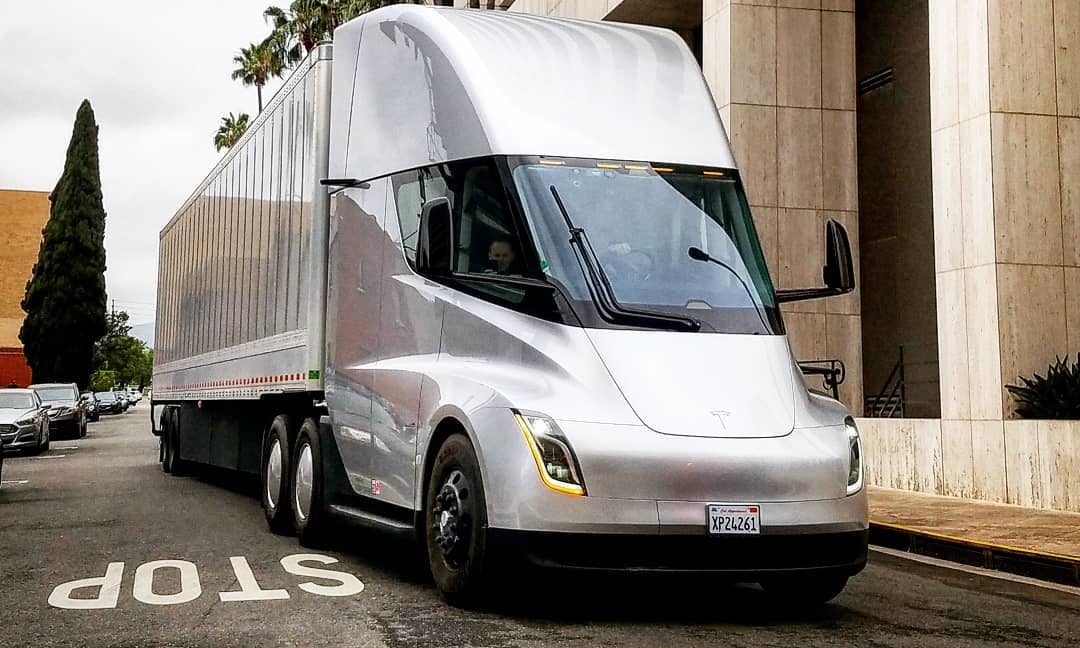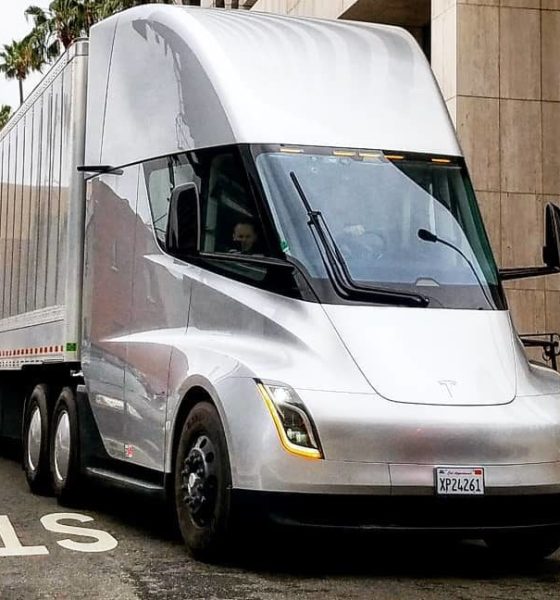

News
Tesla Semi receives warning from Daimler Trucks CEO on ‘difficult’ trucking market
The Tesla Semi is coming, and the trucking industry’s big players are starting to take notice. Among these is Daimler Trucks CEO Martin Daum, who recently stated that his firm is taking the all-electric long hauler from the Silicon Valley company very seriously. While this is the case, though, Daum also noted that it would be very difficult for Tesla to make a dent in the trucking market.
Daum’s latest statements were related in a recent interview during the 2019 Consumer Electronics Show (CES). The Daimler Trucks CEO acknowledged that the Tesla Semi is “fun,” and that the electric car maker has proven itself in the auto market. The veteran executive pointed out, though, that the playing field in the trucking market is something that would be alien to Tesla, at least for now.
“They’re fun; it’s an interesting market. We take every competitor seriously; Tesla has proved they really have the tenacity to really go through huge losses to capture the market. But trucking is a difficult business. They will learn the hard way; trucking is not like passenger cars where one size fits all. There’s a lot of variety in trucking… the United States is a highly competitive market, so as I said, they’re fun,” he said.
The Daimler Trucks CEO stated that the trucking industry spans a number of categories. In North America alone, a region where Daimler Trucks sold 176,000 vehicles in 2018, the company sold several types of vehicles, from school buses and delivery vans to large, specialized trucks that weigh several tons. Daum noted, though, that Daimler is only able to develop and manufacture these trucks because of the company’s global footprint.
This footprint, according to the CEO, is something that Tesla is yet to have.
“How do we survive? Because we run a global business. I don’t just look at the 176,000 North American trucks; I look at the more 500,000 trucks we sell worldwide… And that is a unit number you need to survive ultimately. Of all players in the North American market — Volvo, Navistar, in the association with the Volkswagen Group, and Paccar — we all have one big global footprint.”
“So for Tesla, it is a long way for it to get that. Not making fun of them, we take them seriously. In their niche, they could be successful, but to be ultimately the fifth player in the North American market, it’s a long way, and we won’t make it easy for them.”
While Daum’s recent statements about the Tesla Semi were still a bit dismissive, the CEO’s words are a notable improvement over his initial skepticism of the all-electric long-hauler. After Elon Musk unveiled the specs of the Semi, after all, Daum infamously suggested that the electric truck probably defies the rules of physics. In a statement to Bloomberg, Daum lightly noted that “If Tesla really delivers on this promise, we’ll obviously buy two trucks — one to take apart and one to test because if that happens, something has passed us by. But for now, the same laws of physics apply in Germany and in California.”
Since its unveiling, some members of the trucking industry have started warming up to the idea of an all-electric long-hauler. Sean Chenault, a 16-year veteran of the industry, noted that the vehicle is “a good thing” for the market “as a whole.” Roadmaster Group CEO John Wilbur further pointed out that Tesla’s technologies such as its driver-assist systems would likely push trucking forward.
The Tesla Semi is currently undergoing testing on America’s roads. The silver prototype has been spotted in several states over the past few months, and the matte black test mule (now wrapped in a stunning red), made appearances at a Supercharger as well. During the vehicle’s unveiling, Elon Musk announced that the Semi would start production sometime in 2019, though later statements from Tesla head of investor relations Martin Viecha noted during a Tour of Gigafactory 1 that production of the vehicle would “earnestly” start by 2020.

News
Tesla FSD fleet is nearing 7 billion total miles, including 2.5 billion city miles
As can be seen on Tesla’s official FSD webpage, vehicles equipped with the system have now navigated over 6.99 billion miles.

Tesla’s Full Self-Driving (Supervised) fleet is closing in on almost 7 billion total miles driven, as per data posted by the company on its official FSD webpage.
These figures hint at the massive scale of data fueling Tesla’s rapid FSD improvements, which have been quite notable as of late.
FSD mileage milestones
As can be seen on Tesla’s official FSD webpage, vehicles equipped with the system have now navigated over 6.99 billion miles. Tesla owner and avid FSD tester Whole Mars Catalog also shared a screenshot indicating that from the nearly 7 billion miles traveled by the FSD fleet, more than 2.5 billion miles were driven inside cities.
City miles are particularly valuable for complex urban scenarios like unprotected turns, pedestrian interactions, and traffic lights. This is also the difference-maker for FSD, as only complex solutions, such as Waymo’s self-driving taxis, operate similarly on inner-city streets. And even then, incidents such as the San Francisco blackouts have proven challenging for sensor-rich vehicles like Waymos.
Tesla’s data edge
Tesla has a number of advantages in the autonomous vehicle sector, one of which is the size of its fleet and the number of vehicles training FSD on real-world roads. Tesla’s nearly 7 billion FSD miles then allow the company to roll out updates that make its vehicles behave like they are being driven by experienced drivers, even if they are operating on their own.
So notable are Tesla’s improvements to FSD that NVIDIA Director of Robotics Jim Fan, after experiencing FSD v14, noted that the system is the first AI that passes what he described as a “Physical Turing Test.”
“Despite knowing exactly how robot learning works, I still find it magical watching the steering wheel turn by itself. First it feels surreal, next it becomes routine. Then, like the smartphone, taking it away actively hurts. This is how humanity gets rewired and glued to god-like technologies,” Fan wrote in a post on X.
News
Tesla starts showing how FSD will change lives in Europe
Local officials tested the system on narrow country roads and were impressed by FSD’s smooth, human-like driving, with some calling the service a game-changer for everyday life in areas that are far from urban centers.

Tesla has launched Europe’s first public shuttle service using Full Self-Driving (Supervised) in the rural Eifelkreis Bitburg-Prüm region of Germany, demonstrating how the technology can restore independence and mobility for people who struggle with limited transport options.
Local officials tested the system on narrow country roads and were impressed by FSD’s smooth, human-like driving, with some calling the service a game-changer for everyday life in areas that are far from urban centers.
Officials see real impact on rural residents
Arzfeld Mayor Johannes Kuhl and District Administrator Andreas Kruppert personally tested the Tesla shuttle service. This allowed them to see just how well FSD navigated winding lanes and rural roads confidently. Kruppert said, “Autonomous driving sounds like science fiction to many, but we simply see here that it works totally well in rural regions too.” Kuhl, for his part, also noted that FSD “feels like a very experienced driver.”
The pilot complements the area’s “Citizen Bus” program, which provides on-demand rides for elderly residents who can no longer drive themselves. Tesla Europe shared a video of a demonstration of the service, highlighting how FSD gives people their freedom back, even in places where public transport is not as prevalent.
What the Ministry for Economic Affairs and Transport says
Rhineland-Palatinate’s Minister Daniela Schmitt supported the project, praising the collaboration that made this “first of its kind in Europe” possible. As per the ministry, the rural rollout for the service shows FSD’s potential beyond major cities, and it delivers tangible benefits like grocery runs, doctor visits, and social connections for isolated residents.
“Reliable and flexible mobility is especially vital in rural areas. With the launch of a shuttle service using self-driving vehicles (FSD supervised) by Tesla in the Eifelkreis Bitburg-Prüm, an innovative pilot project is now getting underway that complements local community bus services. It is the first project of its kind in Europe.
“The result is a real gain for rural mobility: greater accessibility, more flexibility and tangible benefits for everyday life. A strong signal for innovation, cooperation and future-oriented mobility beyond urban centers,” the ministry wrote in a LinkedIn post.
News
Tesla China quietly posts Robotaxi-related job listing
Tesla China is currently seeking a Low Voltage Electrical Engineer to work on circuit board design for the company’s autonomous vehicles.

Tesla has posted a new job listing in Shanghai explicitly tied to its Robotaxi program, fueling speculation that the company is preparing to launch its dedicated autonomous ride-hailing service in China.
As noted in the listing, Tesla China is currently seeking a Low Voltage Electrical Engineer to work on circuit board design for the company’s autonomous vehicles.
Robotaxi-specific role
The listing, which was shared on social media platform X by industry watcher @tslaming, suggested that Tesla China is looking to fill the role urgently. The job listing itself specifically mentions that the person hired for the role will be working on the Low Voltage Hardware team, which would design the circuit boards that would serve as the nervous system of the Robotaxi.
Key tasks for the role, as indicated in the job listing, include collaboration with PCB layout, firmware, mechanical, program management, and validation teams, among other responsibilities. The role is based in Shanghai.
China Robotaxi launch
China represents a massive potential market for robotaxis, with its dense urban centers and supportive policies in select cities. Tesla has limited permission to roll out FSD in the country, though despite this, its vehicles have been hailed as among the best in the market when it comes to autonomous features. So far, at least, it appears that China supports Tesla’s FSD and Robotaxi rollout.
This was hinted at in November, when Tesla brought the Cybercab to the 8th China International Import Expo (CIIE) in Shanghai, marking the first time that the autonomous two-seater was brought to the Asia-Pacific region. The vehicle, despite not having a release date in China, received a significant amount of interest among the event’s attendees.








